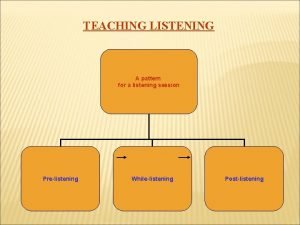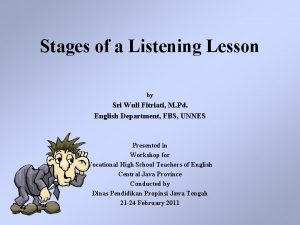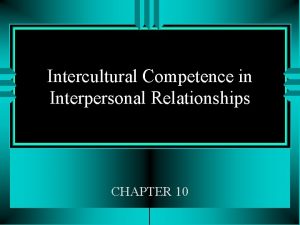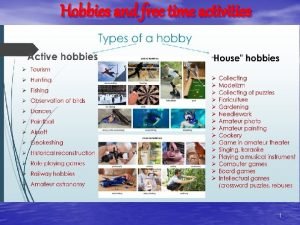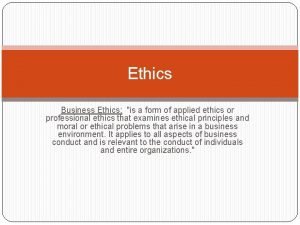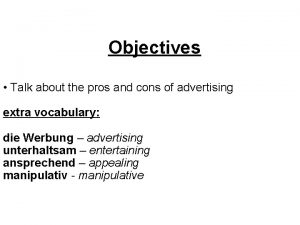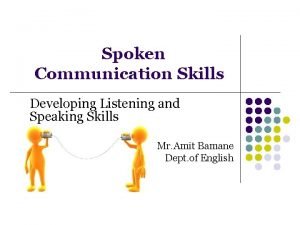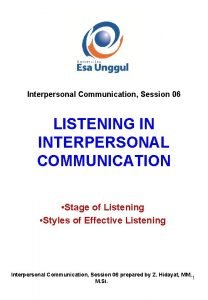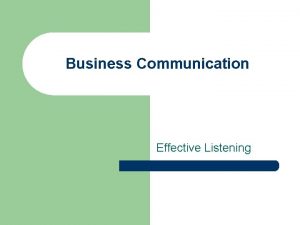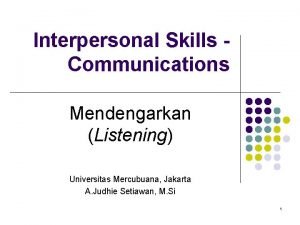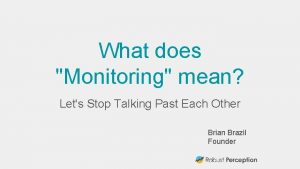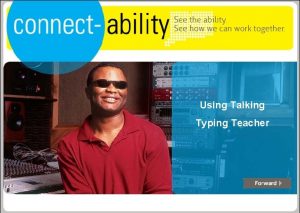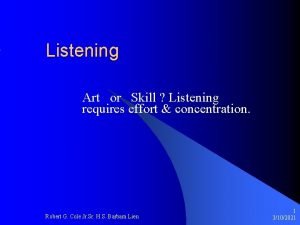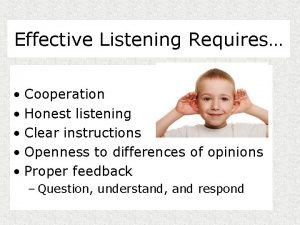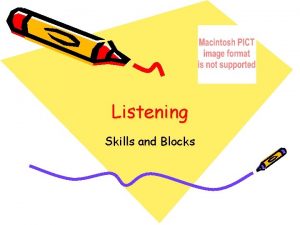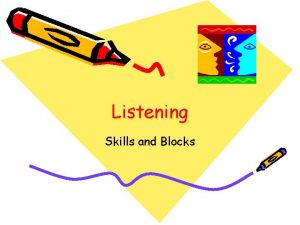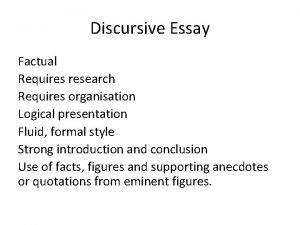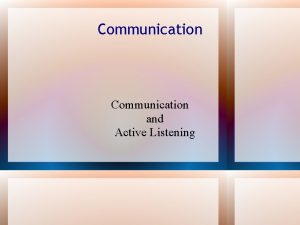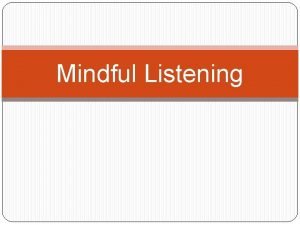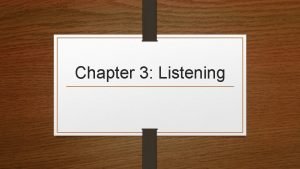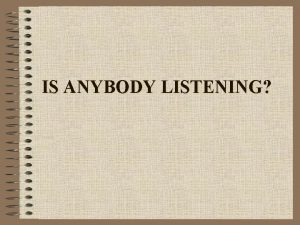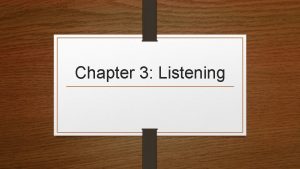LISTENING COMMUNICATION requires talking and LISTENING We all


































- Slides: 34

LISTENING

COMMUNICATION requires talking and LISTENING

We all have a huge need to be listened to We need to learn HOW TO LISTEN

I need to listen to what is going on in your life

BLAH How well do you listen to each other? ? Fluffy

…well I think that was my name being mentioned! Are you really LISTENING… …or just hearing words?

Since we believe that practice makes perfect, we have some short exercises which illustrate the important aspects of listening

EXERCISE 1 Work with another person, NOT your partner Place your chairs back to back One of you to speak for a minute about … …The ways you like to spend your time…. some sport, hobbies, etc. Start now!

What did you notice? How did you feel? It seems to bring out the need to turn our bodies towards the person speaking and to look at them

EXERCISE 2 Turn and face each other. This time the other person will be the speaker Tell the other person about what you did last weekend But the listener must not look at the speaker. Look around, look at your watch, scratch your head etc. You may feel rude, but try it for one minute Start now!

How did you feel talking to someone who was not all interested in what you were saying?

EXERCISE 3 We will now give you an opportunity to practice POSITIVE (ACTIVE) LISTENING This time pair up with your partner and decide who will be the speaker and who will be the listener. Tell your partner about pleasant and unpleasant memories of school days – anything. Memories, teachers, buildings, friends, etc. BUT NOTE…

The listener should say very little. Nod your head. Encourage your partner to say more by your facial expression. Make the odd comment to show you are listening. But don’t tell your own stories. We will give you a signal after two or three minutes then the listener will sum up what they have heard, checking out if they have understood well. Start now!

LISTENER: In your feed back, don’t say: “That reminds me of something that happened when I was at school…” You CAN say “What you liked about school was…” Start now!

How did you feel talking to someone who WAS interested in what you were saying?

*BARRIERS TO LISTENING Fear – of what I am about to be told and the emotional impact it may have on me: “Big boys don’t cry”

*BARRIERS TO LISTENING Reacting – too often we interpret what we hear as criticism, and we react by trying to justify what we have said, or written; we try to defend ourselves, put ourselves in the right

*BARRIERS TO LISTENING Flight - not wanting to listen because of the demands listening may make on me

*BARRIERS TO LISTENING Shut up and give us a kiss! Listening JUST for INFORMATION and not appreciating the person speaking

*BARRIERS TO LISTENING Listening for AFFIRMATION/PRAISE puts the focus on you and not on the speaker…

BARRIERS TO LISTENING *Analysing – listening, but looking for ways you think the person needs your help…. instead of just listening to the thoughts and feelings.

Listening is not a PASSIVE exercise – being just a like sponge soaking up what is being said. *Listening is ACTIVE. We need to clarify what we are hearing. Asking questions like: “Am I right in thinking…? ” Or “Would you explain that feeling to me a little more…”

ACTIVE listening Switch off from your own concerns Make a conscious decision to listen to them in a caring way Face the speaker, give them your full attention, make eye-contact

*Watch for what the person is communicating non-verbally

avoiding eye-contact by body posture

looking bored

What is (s)he feeling right now? *Listen to the FEELINGS behind the words – get in touch with the PERSON rather than the topic (s)he is talking about.

Once they have finished speaking, reflect back in your own words the FEELINGS you have heard, by saying “You’re feeling …because…”

*SOME DON’TS

Don’t interrupt or contradict the speaker

Don’t offer advice or suggestions

I t e g r o …f … t a h t said Don’t console or reassure the speaker – they need the chance to share what is going on inside them. Giving advice may actually close them up, and even make them feel worse.

*LISTENING IS A WAY OF LOVING. It involves a DECISION to love, a love that the speaker EXPERIENCES as you listen to them right now.

MARRIED COUPLE’S SHARING HANDOUT: LISTENING
 Listening pattern
Listening pattern Pre listening while listening post listening activities
Pre listening while listening post listening activities Interpersonal communication competence requires
Interpersonal communication competence requires Draw three noncollinear points j k and l
Draw three noncollinear points j k and l Communication operations
Communication operations Active listening passive listening
Active listening passive listening What is evaluative listening
What is evaluative listening Speaking listening reading writing
Speaking listening reading writing Listening and communication enhancement
Listening and communication enhancement Why was farabi shocked
Why was farabi shocked Free time discussion questions
Free time discussion questions Richard and conway are talking in the hallway
Richard and conway are talking in the hallway 5.6 sequencing asl
5.6 sequencing asl House on mango street edna's ruthie
House on mango street edna's ruthie Talking about pros and cons vocabulary
Talking about pros and cons vocabulary Air force talking paper example
Air force talking paper example Chapter 2 summary of percy jackson the lightning thief
Chapter 2 summary of percy jackson the lightning thief Tung and tu are talking about time management skill
Tung and tu are talking about time management skill What is hammock carry
What is hammock carry Thorndike connectionism
Thorndike connectionism Automated build process
Automated build process Requires unbiased and careful questioning
Requires unbiased and careful questioning After listening to all the arguments
After listening to all the arguments She's all states and all princes i
She's all states and all princes i Total communication process
Total communication process Listening in interpersonal communication
Listening in interpersonal communication In business communication good listening involves -
In business communication good listening involves - Listening non verbal communication
Listening non verbal communication Interpersonal skills listening
Interpersonal skills listening Actual quality-communicated image gap
Actual quality-communicated image gap Talking points example
Talking points example Let's stop talking to each other
Let's stop talking to each other Ctworks
Ctworks Talking traffic kpn
Talking traffic kpn Signing black in america discussion questions
Signing black in america discussion questions
